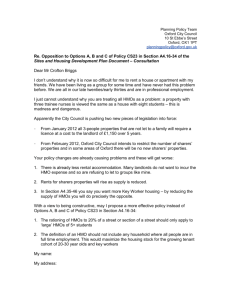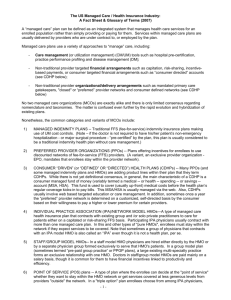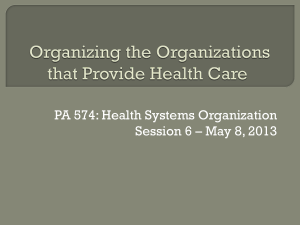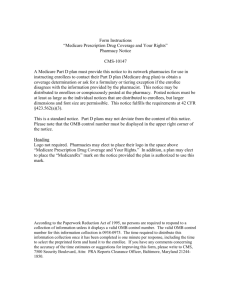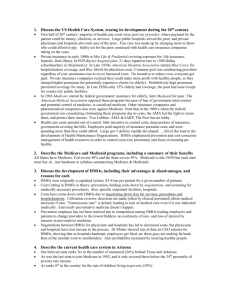findings brief Risk Selection in Employer-Sponsored Managed Care Plans September 2002
advertisement
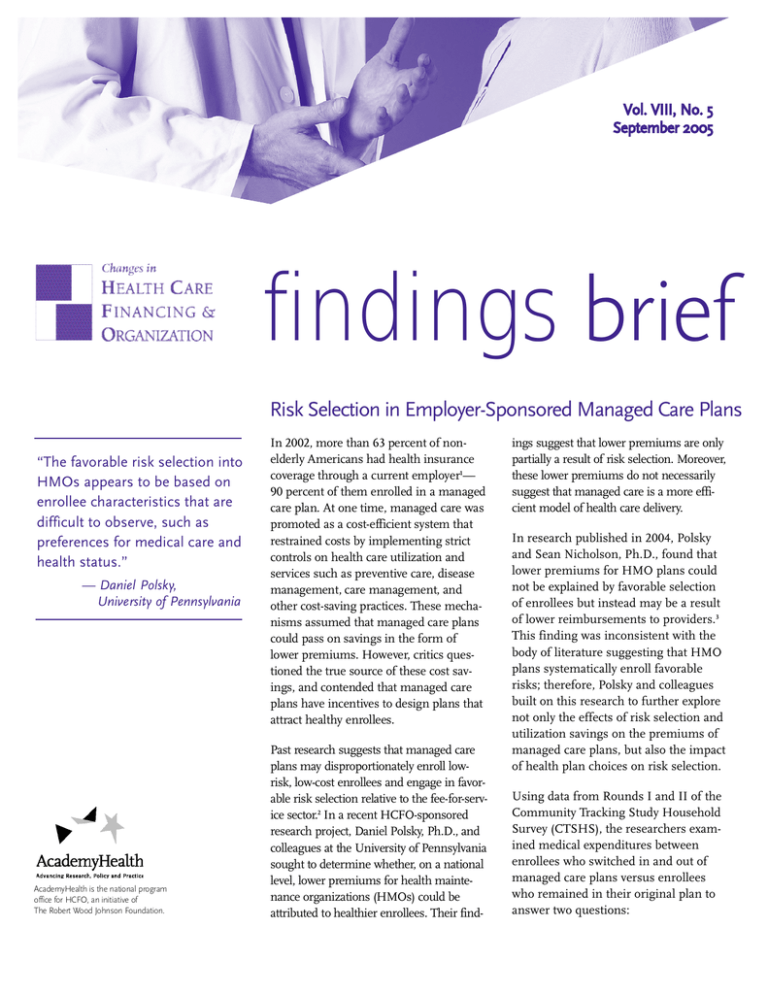
Vol. VIII, No. 5 September 2005 September 2002 Vol. 4 Issue 3 findings brief Risk Selection in Employer-Sponsored Managed Care Plans “The favorable risk selection into HMOs appears to be based on enrollee characteristics that are difficult to observe, such as preferences for medical care and health status.” — Daniel Polsky, University of Pennsylvania AcademyHealth is the national program office for HCFO, an initiative of The Robert Wood Johnson Foundation. In 2002, more than 63 percent of nonelderly Americans had health insurance coverage through a current employer1— 90 percent of them enrolled in a managed care plan. At one time, managed care was promoted as a cost-efficient system that restrained costs by implementing strict controls on health care utilization and services such as preventive care, disease management, care management, and other cost-saving practices. These mechanisms assumed that managed care plans could pass on savings in the form of lower premiums. However, critics questioned the true source of these cost savings, and contended that managed care plans have incentives to design plans that attract healthy enrollees. Past research suggests that managed care plans may disproportionately enroll lowrisk, low-cost enrollees and engage in favorable risk selection relative to the fee-for-service sector.2 In a recent HCFO-sponsored research project, Daniel Polsky, Ph.D., and colleagues at the University of Pennsylvania sought to determine whether, on a national level, lower premiums for health maintenance organizations (HMOs) could be attributed to healthier enrollees. Their find- ings suggest that lower premiums are only partially a result of risk selection. Moreover, these lower premiums do not necessarily suggest that managed care is a more efficient model of health care delivery. In research published in 2004, Polsky and Sean Nicholson, Ph.D., found that lower premiums for HMO plans could not be explained by favorable selection of enrollees but instead may be a result of lower reimbursements to providers.3 This finding was inconsistent with the body of literature suggesting that HMO plans systematically enroll favorable risks; therefore, Polsky and colleagues built on this research to further explore not only the effects of risk selection and utilization savings on the premiums of managed care plans, but also the impact of health plan choices on risk selection. Using data from Rounds I and II of the Community Tracking Study Household Survey (CTSHS), the researchers examined medical expenditures between enrollees who switched in and out of managed care plans versus enrollees who remained in their original plan to answer two questions: issue brief — Changes in Health Care Financing & Organization 1) Do HMOs generate favorable risk selection? 2) How do employee offers, including HMOs as a plan choice, influence enrollment decisions? HMOs and Risk Selection To detect risk selection, the researchers compared medical expenditures in the initial year for people who switched from an HMO to a fee-for-service plan or preferred provider organization, as well as for people who switched from a traditional fee-for-service plan into an HMO. They examined enrollees’ health care utilization for two years. They also examined the risk selection of those who switched in and out of HMOs based on personal characteristics such as age, gender, and income. They found that enrollees who switched into HMOs from traditional plans used 11 percent fewer medical services in the period prior to switching than people who remained in the HMO. This lower level of use continued once they enrolled in an HMO. Similarly, enrollees who switched from HMOs to traditional plans used 18 percent more medical services. Though the higher level of use continued after switching out of an HMO, the difference was not statistically significant. These findings suggest: Favorable risk selection for HMOs does exist among those enrollees switching plans. Because switchers represent a small proportion of enrollees, this phenomenon is responsible for a small proportion of average expenditure differences between HMOs and other plan types. Average expenditure differences are largely a result of discounted reimbursement to providers. “The favorable risk selection into HMOs that does occur would most likely persist even if employers adjusted health plan payments based on enrollees’ gender and age,” says Polsky, “because the selection appears to be based on enrollee characteristics that are difficult to observe, such as preferences for medical care and health status.” page 2 HMOs as a Plan Choice In a related paper,4 Polsky and colleagues found employer offerings that include HMOs as a plan choice influence enrollment decisions. Specifically, they found that if an employer offers only one plan and it is an HMO, take-up is reduced, but overall coverage rates for the employees may increase. “This occurs because married employees will switch to their spouse’s plan, but single employees will enroll in the HMO rather than go uninsured,” says Polsky. Background Managed care plans have gained market share over indemnity insurance and fee-for-service plans while offering consistently lower premiums. Lower premiums could reflect the HMOs’ ability to restrain high-priced services such as name-brand prescription drugs or emergency room use. Alternatively, HMOs may be able to pay physicians and hospitals less by guaranteeing patient referrals. Lower premiums could also result from favorable risk selection. Favorable risk selection can occur when a disproportionate share of low-risk or low-cost beneficiaries join a health plan. According to Polsky, inefficiencies in the market can result if risk selection by managed care plans leaves non-managed care with fewer and disproportionately unhealthy enrollees. Risk selection is possible because few employers adjust premiums based on an enrollee’s expected medical costs. In this case, the health insurer receives equal payments for young, healthy workers as for older or chronically ill enrollees. This creates an incentive for insurance companies to attract low-cost enrollees and deter high-cost enrollees. Several state regulations, such as open enrollment, have been implemented to reduce risk selection between managed care and non-managed care plans. Other regulations such as anywilling-provider laws and out-of-network requirements have the potential to reduce risk selection by limiting the ways plans can attract favorable risk. Risk selection is an important policy issue because it can distort the employee issue brief — Changes in Health Care Financing & Organization premium contribution for enrollees and possibly inhibit the efficient functioning of the health care insurance market.5 Data and Methods Analyzing data from Round I (1996–1997) and Round II (1998–1999) of the CTSHS, the researchers estimated the utilization and riskselection effects of change in the health care system on care delivery and individuals. The data set is unique because it allows researchers to obtain a nationally representative sample and to link respondents available in both Rounds. Past research on risk selection of HMOs in the nonelderly, employer-sponsored market have typically been small case studies. The researchers obtained data on premiums, employee contributions, and plan characteristics. “Using the CTSHS, rather than an employerbased survey, we were able to follow enrollees even after they changed employers,” says Polsky. “Moreover, the CTSHS allowed us to study the degree of risk selection in employer-sponsored health insurance at a national level.” Conclusion Polsky’s findings apply exclusively to employersponsored health insurance markets. Because the mechanisms of switching between health plan types is often more flexible in Medicare managed care and because there is typically a greater diversity in risk levels, Medicare may experience a higher likelihood of favorable risk selection into managed care than in the employer-sponsored health insurance market. “The distinction between management efficiencies and patient selection is critical to assessing the value of managed care,” says Polsky, “because management efficiencies add value, but patient selection merely means that sicker, higher cost patients would have simply become someone else’s cost problem.” He adds that in the end, risk selection plays only a minor role in skewing the apparent value of managed care in reducing health care expenditures in the employer-sponsored health insurance market. However, “if lower reimbursement is indeed the source of expenditure differences, this reflects managed care’s stronger negotiating power with providers rather than management efficiencies,” Polsky says. For more information, contact Daniel Polsky, Ph.D., at 215.573.5752. About the Author Monica Marchetta is an associate with the Changes in Health Care Financing and Organization (HCFO) initiative. She can be reached at 202.292.6700, or monica.marchetta@academyhealth.org. Endnotes 1 Hoffman C. and M. Wang. Health Insurance Coverage in America, 2002 Data Update. Kaiser Family Foundation, Kaiser Commission on Medicaid and the Uninsured, December 2003. www.kff.org/uninsured/upload/HealthInsurance-Coverage-in-America-2002-Data-Update.pdf 2 Call, K.T. et al. “Selection Experiences in Medicare HMOs: Pre-Enrollment Expenditures,” Health Care Financing Review, Vol. 20, No. 4, Summer 1999, pp. 197–209. 3 Polsky D. and S. Nicholson. “Why Are Managed Care Plans Less Expensive: Risk Selection, Utilization, or Reimbursement?” Journal of Risk and Insurance, Vol. 71, No. 1, March 2004, pp. 21–40. 4 Polsky, D., et al. “Employer Health Insurance Offerings and Employee Enrollment Decisions,” Health Services Research, forthcoming. 5 Nicholson, S. et al. “The Magnitude and Nature of Risk Selection in Employer-Sponsored Health Plans,” Health Services Research, Vol. 39, No. 6, Part I, December 2004, pp. 1817–38. page 3 issue brief — Changes in Health Care Financing & Organization page 4 issue brief — Changes in Health Care Financing & Organization page 5
